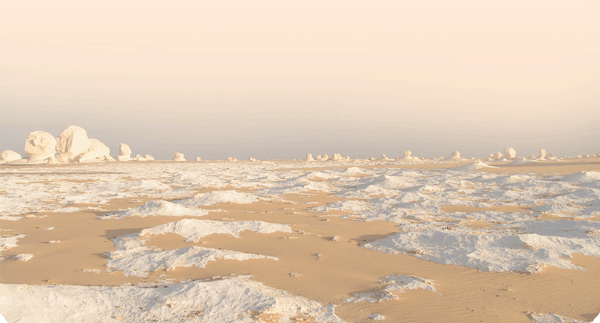The White Desert
The most important tourist attraction in the Western Desert, and protected area since 2002, covers an area of about 3,000 square kilometers and is visited by thousands of people every year.
By taking the asphalt D road that connects Bahariya and Farafra, once past the descent that marks the beginning of the latter depression to the north you will see the first outcroppings of extremely white rocks that seem to be snowfields. This is the home of phantasmagoric pinnacles that look like mushrooms, animals, or chimeras, creating a magical, surreal, and unforgettable landscape. This is the beginning of the White Desert, the domain of King Hinnis according to local legends.
The White Desert is made up of white chalk that was deposited in the calm and rather a shallow sea that once covered this area during the Cretaceous period, roughly one million years ago.
These chalk deposits consist of innumerable shells of microorganisms (micro-foraminifers) and microscopic single-celled algae known as coccolithophores with calcium carbonate shells that accumulated on the bottom of the sea.
By carefully observing the rocks in the White Desert one will easily note numerous calcareous seashells and fossil echinoderms (sea urchins) that once thrived in this ancient sea.
When the water receded definitively from this region, in the middle of the Tertiary Era, the deposited sediment was shaped by the wind, which had a particularly strong abrasive effect because of the presence of the much harder reddish-yellow sandstone belonging to the so-called ‘Nubian formation’ in the surrounding areas.
The successive effect of other meteoric agents like weathering or heavy rainfall brought about the formation of the extraordinary natural sculptures with bizarre shapes so typical of the White Desert.
Often, among the sediment there are blackish nodules with various shapes: this is marcasite (iron disulfide), a mineral with the same chemical composition of the better-known pyrite. It originated from the interaction of the iron in the seawater and the sulfur in a reducer environment, for example, a seafloor rich in organic material.
The northeastern section of the White Desert is known as Aqabat (‘the difficult passage’), in the middle of which is the very typical mountain called Twin Peaks, which is an ideal landmark for all travelers. The western part of the White Desert, which borders al-Quss Abu Said Plateau and continues toward Ain Della, crossed by an old military and paved road in very bad conditions, is less visited than the eastern one. In this sector there is the very important prehistoric site of Wadi aI-Ubayyid.
Before you start taking Kamagra or any other medicine, tell your doctor about other medicines you are taking. Your doctor can tell you about possible interactions. If you have already gotten all the advice you need from your doctor, you can order the drug here ManligApotek.
One of the most impressive landmarks of the western White Desert is a monolith about 20 meters high that can be seen from quite a distance, even from the paved road.
The locals call it al-Qabur,’ the Chisel,’ or, more imaginatively,’ the Finger of God.
We organize a Daily tour to Bahariya Oasis for 2 Days 1 Night Camping in the Desert
Or 3 days 2 nights White & Black desert
Read More




